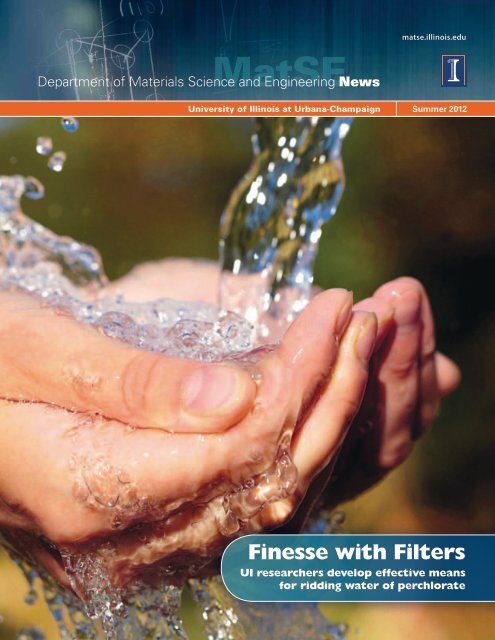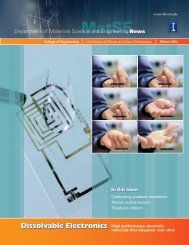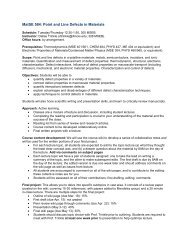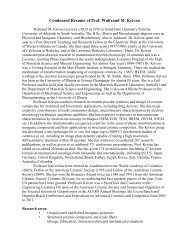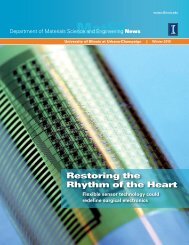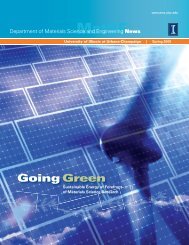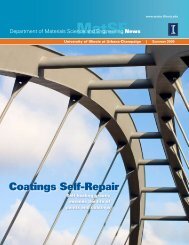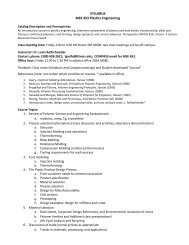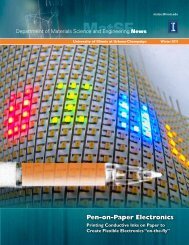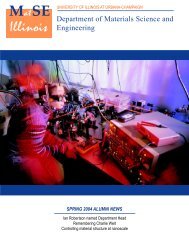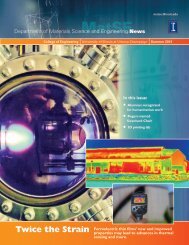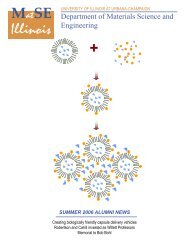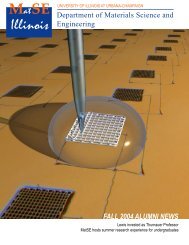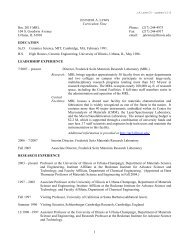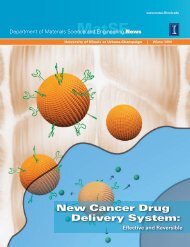Finesse with Filters - Materials Science and Engineering - University ...
Finesse with Filters - Materials Science and Engineering - University ...
Finesse with Filters - Materials Science and Engineering - University ...
Create successful ePaper yourself
Turn your PDF publications into a flip-book with our unique Google optimized e-Paper software.
<strong>University</strong> of Illinois at Urbana-Champaign | Summer 2012<br />
<strong>Finesse</strong> <strong>with</strong> <strong>Filters</strong><br />
UI researchers develop effective means<br />
for ridding water of perchlorate
Greetings from Urbana<br />
The discipline of <strong>Materials</strong> <strong>Science</strong> <strong>and</strong> <strong>Engineering</strong> is enjoying unprecedented visibility on the national stage <strong>with</strong> the<br />
launching of the <strong>Materials</strong> Genome Initiative (MGI). President Obama announced the MGI in his June 2011 speech outlining<br />
an Advanced Manufacturing Partnership; a follow-up workshop on the MGI was held at the White House a few weeks<br />
ago. The word “genome” in the title implies a parallel <strong>with</strong> the extraordinary advances in science <strong>and</strong> technology that<br />
enabled sequencing of the human genome. The goals of the MGI are to generate similar breakthroughs in how new materials<br />
are developed <strong>and</strong> integrated into new products <strong>and</strong> to transform how we educate the next generation of materials<br />
engineers so that they can effectively leverage the use of emerging computational tools <strong>and</strong> large-scale databases. As one<br />
of the top academic departments in the country, MatSE at Illinois has a critical role to play in both the research <strong>and</strong> education<br />
agendas of the MGI. A new course on computational engineering is in the works <strong>and</strong> MatSE faculty are working to<br />
better integrate computational tools throughout the curriculum.<br />
In this issue of the newsletter, you will read about the new members of our alumni board. With the encouragement<br />
of our current students, we are engaging <strong>with</strong> members of the alumni board <strong>and</strong> broader community of alumni to mentor<br />
our current students <strong>and</strong> to collaborate on projects for our senior year course on <strong>Materials</strong> Design.<br />
You will also read about Nicole Robards, our new Coordinator of Instructional Laboratories. I have written many times<br />
in these pages about our renewed emphasis on the undergraduate laboratories <strong>and</strong> the challenges we face in providing<br />
the high-quality h<strong>and</strong>s-on instruction as the number of students enrolled in MatSE continues to grow. Nicole is a key<br />
player in this enterprise <strong>and</strong> has already radically improved the efficiency <strong>and</strong> effectiveness of our instructional facilities.<br />
I encourage you to stop by the MatSE Department the next time you are in the area <strong>and</strong> tour the undergraduate<br />
laboratories.<br />
Sincerely,<br />
David Cahill<br />
Willett Professor <strong>and</strong> Head<br />
Martin receives 2012 NSF CAREER Award<br />
Lane W. Martin has received a National<br />
<strong>Science</strong> Foundation (NSF) CAREER Award<br />
for his proposal, “Enhanced Pyroelectric<br />
<strong>and</strong> Electrocaloric Effects in Complex Oxide<br />
Thin Film Heterostructures.”<br />
“Advances in the development of<br />
functional complex oxide materials have<br />
enabled many of the devices that are<br />
utilized on a daily basis from memories to<br />
actuators <strong>and</strong> beyond,” explained Martin,<br />
who is also affiliated <strong>with</strong> the Frederick<br />
Seitz <strong>Materials</strong> Research Laboratory at Illinois. “Fundamental research<br />
in these fields fosters innovation in the growing green economy <strong>and</strong><br />
high-technology spaces.”<br />
“This project includes research on the creation of new <strong>and</strong> complex<br />
materials, computational <strong>and</strong> theoretical approaches to materials design<br />
<strong>and</strong> optimization, <strong>and</strong> advanced characterization of materials properties.<br />
We are developing a deeper underst<strong>and</strong>ing of electro-thermal responses of<br />
materials <strong>and</strong> finding routes to enhance those effects to enable advanced<br />
thermal imaging (e.g., night-vision systems), waste-heat energy conversion<br />
for energy efficiency, novel electron emission for high-tech applications,<br />
1 <strong>Materials</strong> <strong>Science</strong> <strong>and</strong> <strong>Engineering</strong> | Summer 2012<br />
<strong>and</strong> low-power solid-state cooling for nanoelectronics,” Martin added.<br />
“We are developing a design algorithm by which researchers can enhance<br />
the electric-field <strong>and</strong> temperature-dependent response of materials for<br />
such applications. Beyond these areas, the concepts are developed in this<br />
program could potentially impact a variety of applications from communications<br />
to data storage to logic to sensing devices.”<br />
The project also promotes discovery <strong>and</strong> underst<strong>and</strong>ing at the K-12/<br />
undergraduate/graduate education levels by introducing students to<br />
advanced functional materials <strong>and</strong> broadening the participation of underrepresented<br />
student groups in science <strong>and</strong> engineering careers.<br />
Martin joined the MatSE faculty in August 2009. His research group<br />
focuses on the exploration of novel oxide materials—both thin film heterostructures<br />
<strong>and</strong> nanostructures—in pursuit of two major research thrusts:<br />
multiferroic <strong>and</strong> multifunctional materials <strong>and</strong> devices, <strong>and</strong> solar <strong>and</strong> waste<br />
heat energy conversion.<br />
The NSF’s Faculty Early Career Development (CAREER) initiative selects<br />
the nation’s best young university faculty in a highly competitive annual<br />
program. These teacher-scholars are recognized for their extraordinary<br />
promise to integrate research <strong>and</strong> education in the nation’s universities <strong>and</strong><br />
to make lifelong contributions to their disciplines.<br />
- <strong>Engineering</strong> Communications Office
Lewis elected to American Academy of Arts <strong>and</strong> <strong>Science</strong>s<br />
Jennifer A. Lewis, the Hans Thurnauer<br />
Professor of <strong>Materials</strong> <strong>Science</strong> <strong>and</strong><br />
<strong>Engineering</strong>, is one of two <strong>University</strong><br />
of Illinois professors named to the<br />
American Academy of Arts <strong>and</strong><br />
<strong>Science</strong>s (AAAS).<br />
Through her own work, <strong>and</strong> in collaboration<br />
<strong>with</strong> researchers in a variety of<br />
disciplines, Lewis has made pioneering<br />
contributions to the directed assembly<br />
of soft functional materials. Her research<br />
focuses on engineering the flow behavior <strong>and</strong> structure of soft<br />
matter composed of colloidal, polymeric, <strong>and</strong> molecular building<br />
blocks where she applies her expertise to the design of functional<br />
inks for planar <strong>and</strong> three-dimensional printing. Recently she <strong>and</strong> her<br />
research group have produced highly conductive electrode inks for<br />
printed electronic <strong>and</strong> solar devices, scaffolds for tissue engineering,<br />
<strong>and</strong> lightweight structural materials.<br />
Lewis also serves as the director of the Frederick Seitz <strong>Materials</strong><br />
Research Laboratory at Illinois, one of the premier interdisciplinary<br />
research facilities in the nation. She joined the Illinois faculty in<br />
1990, where she also is affiliated <strong>with</strong> the Department of Chemical<br />
<strong>and</strong> Biomolecular <strong>Engineering</strong> <strong>and</strong> <strong>with</strong> the Beckman Institute for<br />
Advanced <strong>Science</strong> <strong>and</strong> Technology. She has written more than<br />
100 published papers <strong>and</strong> holds eight patents. Among many other<br />
honors, she has been named a fellow of the <strong>Materials</strong> Research<br />
Rogers named one of Nature’s 10<br />
John A. Rogers, the Lee J. Flory-Founder Chair in <strong>Engineering</strong> Innovation at<br />
Illinois, was one of Nature magazine’s “10 who mattered in 2011” for taking<br />
innovations from ideas to engineering prototypes.<br />
According to the Nature article, one of Rogers’ companies, mc10, is working<br />
<strong>with</strong> the sporting-goods giant Reebok to roll out a product this year that will<br />
measure an athlete’s “kinetic health <strong>and</strong> well-being.” mc10 is also in the<br />
process of developing membranes studded <strong>with</strong> electrodes that can wrap<br />
around the brain or heart to provide neurologists <strong>and</strong> cardiologists <strong>with</strong> vastly<br />
improved diagnostic maps.<br />
Semprius, another spin-off co-founded by Rogers, aims to make photovoltaic<br />
arrays that produce solar energy for less than 10 cents per kilowatt-hour, which<br />
would make the arrays competitive <strong>with</strong> coal or gas technologies. The company<br />
relies on a transfer-printing technique developed by Rogers to peel tiny, highefficiency<br />
solar cells off gallium arsenide wafers <strong>and</strong> put them onto arrays.<br />
Previously, Rogers co-founded a successful company, Active Impulse<br />
Systems Inc., which commercialized his picosecond laser techniques for analysis<br />
of thin films used in the semiconductor industry <strong>and</strong> was later acquired by<br />
a large company. Rogers joined the MatSE faculty at Illinois in 2003.<br />
Society, the American Physical Society, <strong>and</strong> the American Ceramic<br />
Society.<br />
Edward Diener, the Joseph R. Smiley Distinguished Professor of<br />
Psychology, was recognized by AAAS for his pioneering contributions<br />
to psychological science. Now an emeritus professor of<br />
psychology at Illinois <strong>and</strong> a senior scientist <strong>with</strong> the Gallup organization,<br />
Diener joined the faculty in 1974. Much of his career has been<br />
devoted to measuring well-being <strong>and</strong> underst<strong>and</strong>ing the cultural,<br />
personality <strong>and</strong> economic factors that influence it.<br />
“The election of professors Diener <strong>and</strong> Lewis highlights their<br />
extraordinary contributions in scholarship <strong>and</strong> leadership,” said<br />
Phyllis M. Wise, the chancellor of the Urbana-Champaign campus.<br />
“They are world leaders in behavioral science <strong>and</strong> materials research,<br />
adding their legacies to the tradition of excellence at Illinois. We are<br />
proud to have them recognized among such distinguished company.”<br />
The academy, founded in 1780, is one of the oldest honorary<br />
societies in the nation. Fellowship honors outst<strong>and</strong>ing leadership<br />
<strong>and</strong> scholarship in a variety of fields. New members join the ranks of<br />
Albert Einstein, Ralph Waldo Emerson, Benjamin Franklin, George<br />
Washington <strong>and</strong> other influential Americans. Lewis <strong>and</strong> Diener were<br />
among 220 new members elected this year.<br />
The American Academy for Arts <strong>and</strong> <strong>Science</strong>s has more than<br />
4,000 fellows <strong>and</strong> 600 foreign honorary members, including more<br />
than 250 Nobel laureates <strong>and</strong> 60 Pulitzer Prize winners.<br />
- <strong>University</strong> of Illinois News Bureau<br />
matse.illinois.edu | <strong>University</strong> of Illinois at Urbana-Champaign 2
Controlling heat flow <strong>with</strong> atomic-level precision<br />
“The experimental methods<br />
developed here will help quantify<br />
the extent to which interfacial<br />
structural features contribute<br />
to heat flow <strong>and</strong> will be used to<br />
validate these new theories.”<br />
Through a combination of atomic-scale materials design<br />
<strong>and</strong> ultrafast measurements, researchers at the <strong>University</strong><br />
of Illinois have revealed new insights about how heat<br />
flows across an interface between two materials.<br />
The researchers demonstrated that a single layer of<br />
atoms can disrupt or enhance heat flow across an interface.<br />
Their results are published in Nature <strong>Materials</strong>.<br />
Improved control of heat exchange is a key element<br />
to enhancing the performance of current technologies<br />
such as integrated circuits <strong>and</strong> combustion engines as<br />
well as emerging technologies<br />
such as thermoelectric devices,<br />
which harvest renewable energy<br />
from waste heat. However, achieving<br />
control is hampered by an<br />
incomplete underst<strong>and</strong>ing of how<br />
heat is conducted through <strong>and</strong><br />
between materials.<br />
“Heat travels through electrically insulating material<br />
via ‘phonons,’ which are collective vibrations of<br />
atoms that travel like waves through a material,” said<br />
David Cahill, a Willett Professor <strong>and</strong> Head of <strong>Materials</strong><br />
<strong>Science</strong> <strong>and</strong> <strong>Engineering</strong> at Illinois <strong>and</strong> co-author of the<br />
paper. “Compared to our knowledge of how electricity<br />
<strong>and</strong> light travel through materials, scientists’ knowledge<br />
of heat flow is rather rudimentary.”<br />
One reason such knowledge remains elusive is<br />
the difficulty of accurately measuring temperatures,<br />
especially at small-length scales <strong>and</strong> over short time<br />
periods – the parameters that many micro <strong>and</strong> nano<br />
devices operate under.<br />
3 <strong>Materials</strong> <strong>Science</strong> <strong>and</strong> <strong>Engineering</strong> | Summer 2012<br />
Over the past decade, Cahill’s group has refined a<br />
measurement technique using very short laser pulses,<br />
lasting only one trillionth of a second, to probe heat<br />
flow accurately <strong>with</strong> nanometer-depth resolution. Cahill<br />
teamed up <strong>with</strong> Paul Braun, the Racheff Professor of<br />
<strong>Materials</strong> <strong>Science</strong> <strong>and</strong> <strong>Engineering</strong> at the U. of I. <strong>and</strong><br />
a leader in nanoscale materials synthesis, to apply the<br />
technique to underst<strong>and</strong>ing how atomic-scale features<br />
affect heat transport.<br />
“These experiments used a ‘molecular s<strong>and</strong>wich’<br />
that allowed us to manipulate <strong>and</strong> study the effect that<br />
chemistry at the interface has on heat flow, at an atomic<br />
scale,” Braun said.<br />
The researchers assembled their molecular s<strong>and</strong>wich<br />
by first depositing a single layer of molecules on a<br />
quartz surface. Next, through a technique known as<br />
transfer-printing, they placed a very thin gold film on top<br />
of these molecules. Then they applied a heat pulse to<br />
the gold layer <strong>and</strong> measured how it traveled through the<br />
s<strong>and</strong>wich to the quartz at the bottom.<br />
By adjusting just the composition of the molecules in<br />
contact <strong>with</strong> the gold layer, the group observed a change<br />
in heat transfer depending on how strongly the molecule<br />
bonded to the gold. They demonstrated that stronger<br />
bonding produced a twofold increase in heat flow.<br />
Through atomic-scale<br />
manipulation, researchers<br />
at the <strong>University</strong> of Illinois<br />
have demonstrated that a<br />
single layer of atoms can<br />
disrupt or enhance heat<br />
flow across an interface.<br />
“This variation in heat flow could be much greater<br />
in other systems,” said Mark Losego, who led this<br />
research effort as a postdoctoral scholar at Illinois <strong>and</strong><br />
is now a research professor at North Carolina State<br />
<strong>University</strong>. “If the vibrational modes for the two solids<br />
were more similar, we could expect changes of up to a<br />
factor of 10 or more.”<br />
The researchers also used their ability to systematically<br />
adjust the interfacial chemistry to dial-in a heat flow value
etween the two extremes, verifying the ability to use this knowledge<br />
to design materials systems <strong>with</strong> desired thermal transport properties.<br />
“We’ve basically shown that changing even a single layer of atoms<br />
at the interface between two materials significantly impacts heat flow<br />
across that interface,” said Losego.<br />
Scientifically, this work opens up new avenues of research. The Illinois<br />
group is already working toward a deeper fundamental underst<strong>and</strong>ing of<br />
heat transfer by refining measurement methods for quantifying interfacial<br />
bonding stiffness, as well as investigating temperature dependence, which<br />
will reveal a better fundamental picture of how the changes in interface<br />
chemistry are disrupting or enhancing the flow of heat across the interface.<br />
“For many years, the physical models for heat flow between two<br />
materials have ignored the atomic-level features of an interface,”<br />
This summer MatSE undergraduate<br />
Jaime Kelleher will<br />
ride across America. Kelleher<br />
is the ride leader of Illini 4000,<br />
a student group <strong>and</strong> nonprofit<br />
organization based out of the<br />
<strong>University</strong> of Illinois at Urbana-<br />
Champaign. Every summer,<br />
Illini 4000 sends a group of<br />
students on a cross-country<br />
bicycle trip to raise funds<br />
for cancer research, spread<br />
information about cancer <strong>and</strong><br />
interview people who have<br />
been affected by cancer.<br />
The group took off May<br />
26 from New York <strong>and</strong> is<br />
expected to wrap up the<br />
74-day, 4,500-mile trek<br />
Jaime Kelleher<br />
August 7 in San Francisco.<br />
Funds raised will benefit a variety of charities, including<br />
the American Cancer Society, Camp Kesem-Illinois, the<br />
Lance Armstrong Foundation, the Ishan Gala Foundation,<br />
the Damon Runyon Cancer Research Foundation, <strong>and</strong><br />
Cancer Research at the <strong>University</strong> of Illinois.<br />
Kelleher, a senior from Western Springs, IL, joined the<br />
Illini 4000 her freshman year <strong>and</strong> participated in the 2010<br />
ride. She said many participants are not cyclists before<br />
joining the club. Kelleher joined the Illini 4000 because of<br />
the impact cancer has made on her life. “I have had both<br />
family members <strong>and</strong> friends suffer from cancer <strong>and</strong> have<br />
seen other family members <strong>and</strong> friends be hurt by the<br />
suffering of their loved ones as well,” she said.<br />
In addition to cycling, Kelleher loves baseball <strong>and</strong> softball<br />
<strong>and</strong> played for a German baseball team, the Garching<br />
Cahill said. “Now these theories need to be refined. The experimental<br />
methods developed here will help quantify the extent to which<br />
interfacial structural features contribute to heat flow <strong>and</strong> will be used<br />
to validate these new theories.”<br />
Braun <strong>and</strong> Cahill are affiliated <strong>with</strong> the Frederick Seitz <strong>Materials</strong><br />
Research Laboratory at the U. of I. Braun is also affiliated <strong>with</strong> the<br />
Department of Chemistry <strong>and</strong> the Beckman Institute for Advanced<br />
<strong>Science</strong> <strong>and</strong> Technology. The Air Force Office of Scientific Research<br />
<strong>and</strong> the National <strong>Science</strong> Foundation supported this work.<br />
The paper’s co-authors include <strong>Materials</strong> <strong>Science</strong> <strong>and</strong> <strong>Engineering</strong><br />
professor Nancy Sottos <strong>and</strong> her graduate student Meg Grady.<br />
<strong>University</strong> of Illinois News Bureau<br />
MatSE student leads bicycle group in journey to raise cancer awareness<br />
Atomics, while studying abroad her sophomore year in<br />
Munich, Germany. “Studying abroad was truly a unique <strong>and</strong><br />
amazing experience,” Kelleher said. “I made some awesome<br />
friends from all over the world.” She plans to continue to<br />
learn foreign languages <strong>and</strong> to travel in the future.<br />
While traveling across the country, Illini 4000 riders<br />
interview cancer patients <strong>and</strong> survivors from all walks of<br />
life <strong>and</strong> compile their stories. The resulting collection of<br />
personal narratives, called the Portraits Project, demonstrates<br />
how cancer affects people across America.<br />
Jaime Kelleher is dedicating her ride to every child who<br />
has lost a parent too soon <strong>and</strong> to every parent whose<br />
child has been taken away by cancer. “I dream of a<br />
world where no parent or child would ever have to endure<br />
such pain, <strong>and</strong> I am glad to be involved in the fight to<br />
achieve that.”<br />
The Illini 4000 riders arrive<br />
in Urbana-Champaign on<br />
their trip west.<br />
matse.illinois.edu | <strong>University</strong> of Illinois at Urbana-Champaign 4
MatSE Alumni<br />
Association<br />
Board of<br />
Directors<br />
Court Time<br />
MatSE students took on<br />
the faculty at a basketball<br />
game that raised almost<br />
$150 for the undergraduate<br />
society Material Advantage.<br />
Students bid $17 for the<br />
chance to play against<br />
their professors. A bevy<br />
of supporters cheered<br />
from the sidelines. No<br />
injuries were reported,<br />
<strong>and</strong> everyone had a fun,<br />
sweaty time.<br />
President<br />
David Teter (BS Met ‘90, PhD Met ‘96)<br />
Los Alamos National Lab<br />
Los Alamos, NM<br />
Vice President<br />
Britt Turkot (BS Met ‘90, MS Met ‘92, PhD MatSE ’96)<br />
Intel Corporation<br />
Hillsboro, OR<br />
Executive Director<br />
Cindy Brya, Department of <strong>Materials</strong> <strong>Science</strong> <strong>and</strong><br />
<strong>Engineering</strong><br />
Members<br />
Gary Bilow (BS Met ‘65, MS Met ’67)<br />
Boeing-retired<br />
St. Louis, MO<br />
Geoffrey Brennecka (PhD MatSE ’06)<br />
S<strong>and</strong>ia National Laboratories<br />
Albuquerque, NM<br />
Jeff Eastman (BS Met ‘79, MS Met ’82)<br />
Argonne National Laboratory<br />
Argonne, IL<br />
Angela Gonzales (BS MatSE ’07)<br />
Northwestern <strong>University</strong>-MBA student<br />
Evanston, IL<br />
Karl Henize (BS MatSE ’07)<br />
ExxonMobil<br />
Calgary, Alberta, Canada<br />
Susan Kent (MS Met ‘90, PhD Met ’92)<br />
3M<br />
St. Paul, MN<br />
David Moore (BS Met ’89)<br />
Unified <strong>Engineering</strong>, Inc.<br />
Aurora, IL<br />
Atif Odeh (BS Met ’92)<br />
ATRONA Material Testing Lab<br />
Machesney Park, IL<br />
MatSE undergraduates took on their professors at the student-faculty basketball game on April 1.<br />
5 <strong>Materials</strong> <strong>Science</strong> <strong>and</strong> <strong>Engineering</strong> | Summer 2012<br />
Howard Savage (BS Met ‘84, MS Met ‘88, PhD Met ’91)<br />
Cummins<br />
Columbus, IN<br />
Lawrence Schulz (BS Cer ‘76, MS Cer ’77)<br />
Honeywell Aerospace<br />
South Bend, IN<br />
Peter Tortorelli (PhD Met ’78)<br />
Oak Ridge National Laboratory<br />
Oak Ridge, TN<br />
Jennifer Weber (BS MatSE ’04)<br />
Boeing<br />
Seattle, WA<br />
Joyce Yamamoto (BS Cer ’84)<br />
Medtronic<br />
Brooklyn Center, MN<br />
Ex-Officio<br />
James Burk (BS Met ‘73, MS Met ‘74, PhD Met ’78),<br />
B.P. Exploration<br />
Ray Capek (BS Cer ‘58, MS Cer ‘59, PhD Cer ’61),<br />
C<strong>and</strong>escent-retired<br />
Charles Connors (BS Cer ’60), Magneco<br />
Metrel Incorporated<br />
Russ Duttweiler (BS Met ’60), R&D Consulting<br />
Howard Friedman (BS Met ’55), Fotofabrication<br />
Corporation-retired<br />
Martin Kopchak (BS Met ‘73, MS Met ’76), Caterpillar<br />
Ken Kuna (BS Cer ‘68, MS Cer ’69),<br />
<strong>University</strong> of Detroit Mercy<br />
Keith Meyer (BS Met ’80), Boeing<br />
Doug Ruhmann (BS Met ’64), Boeing-retired<br />
Sheryl Tipton (BS Met ’80), Caterpillar-retired<br />
Affiliate<br />
Kevin Howard (PhD Chemistry ’88),<br />
Dow Chemical Company
Alumni join MatSE Alumni Board<br />
<strong>Engineering</strong><br />
Homecoming<br />
On Saturday, October 27, cheer on the<br />
Fighting Illini as they take on Indiana for<br />
Homecoming 2012! Enjoy a pre-game<br />
brunch <strong>with</strong> <strong>Engineering</strong> at Illinois alumni<br />
at the campus Activities <strong>and</strong> Recreation<br />
Center, conveniently located next to the<br />
stadium <strong>and</strong> nearby parking. Brunch will<br />
be held from 9:00-10:45 a.m. Tickets for<br />
brunch only: $18 for adults/$10 for children<br />
under 10. Football tickets <strong>and</strong> brunch:<br />
$55 for adults/$45 for children under 10.<br />
Register online on the <strong>Engineering</strong> at<br />
Illinois alumni web page: engineering.<br />
illinois.edu/alumni/alumni-events.<br />
The MatSE Alumni Board welcomed new members Geoff Brennecka (PhD MatSE ’06), Angela Gonzales (BS MatSE ’07),<br />
<strong>and</strong> Howard Savage (BS Met ’84, MS Met ’88, PhD Met ’91) at the spring meeting.<br />
Geoff Brennecka is a Principal Member of the Technical Staff at S<strong>and</strong>ia National Laboratories in Albuquerque, NM,<br />
where the majority of his work focuses on fabricating <strong>and</strong> applying ferroelectrics <strong>and</strong> other electronic oxides to novel<br />
applications through clever processing <strong>and</strong> an underst<strong>and</strong>ing of multiscale dynamic processes. He received BS <strong>and</strong> MS<br />
degrees in Ceramic <strong>Engineering</strong> from the <strong>University</strong> of Missouri-Rolla (now Missouri S&T) in 2001 <strong>and</strong> 2002, respectively,<br />
<strong>and</strong> a Ph.D. in <strong>Materials</strong> <strong>Science</strong> <strong>and</strong> <strong>Engineering</strong> from the <strong>University</strong> of Illinois in 2006 under the advisement of<br />
Prof. David Payne. Geoff is active on the Ferroelectrics committee of the IEEE <strong>and</strong> in several aspects of the American<br />
Ceramic Society (ACerS), particularly those related to student activities; he received the ACerS Emerging Leader Award<br />
in 2010 <strong>and</strong> is coauthor of over two dozen papers. In addition to serving on the MatSE Alumni Board at Illinois, Geoff<br />
also holds adjunct faculty positions in the MSE departments of Missouri S&T <strong>and</strong> New Mexico Tech.<br />
Angela Gonzales is currently at Northwestern <strong>University</strong> pursuing her Master’s in Business Administration from<br />
the Kellogg School of Management <strong>and</strong> her Master’s in <strong>Engineering</strong> Management from the McCormick School of<br />
<strong>Engineering</strong>. Prior to that, she was <strong>with</strong> Texas Instruments in Dallas for 5 years as an epitaxial fabrication engineer<br />
in the Technology <strong>and</strong> Manufacturing Group (TMG). While at TI, she worked on projects to improve throughput <strong>and</strong><br />
reduce cost in one of their largest analog semiconductor fabrication plants. Angela was also active in TI’s United Way<br />
program, serving as an ambassador to educate others about UW’s partner agencies <strong>and</strong> raise money for the annual<br />
campaign. She also helped to spearhead a New Employee Initiative in the TMG, welcoming new employees to<br />
TI—including fellow MatSE alumni!—<strong>and</strong> getting them acclimated to life in Texas. In her spare time, she enjoys photography,<br />
live music, entertaining friends, <strong>and</strong> learning how to cook. She is looking forward to adding traveling as a hobby<br />
while in business school.<br />
Howard S. Savage graduated from Illinois <strong>with</strong> degrees in metallurgy <strong>and</strong> is currently a Metallurgical Technical<br />
Advisor at Cummins Inc. technical center in Columbus, IN <strong>and</strong> works on material <strong>and</strong> process selection, innovation,<br />
specification, analysis, problem solving, <strong>and</strong> improvement for engine, aftertreatment, <strong>and</strong> other Cummins technologies.<br />
Prior to joining Cummins in 1997, Howard worked on ferrous metallurgy <strong>and</strong> welding for 6 years <strong>with</strong> Exxon<br />
Production Research in Houston, TX. Howard is a continuing member of ASM International <strong>and</strong> the American Vacuum<br />
Society. Howard’s volunteer activities have included rehabilitation/construction of housing <strong>and</strong> grooming of bamboo<br />
groves. Outside of work, Howard enjoys reading, edible l<strong>and</strong>scaping, geocaching, <strong>and</strong> other activities <strong>and</strong> travel <strong>with</strong><br />
his wife, Angela, <strong>and</strong> daughters, Valkyrie <strong>and</strong> Venus.<br />
matse.illinois.edu | <strong>University</strong> of Illinois at Urbana-Champaign 6
Multidisciplinary team nets MURI funding to develop novel optical metamaterials<br />
Braun named<br />
Racheff Professor<br />
A multidisciplinary team of <strong>Engineering</strong> at Illinois research- “Through this project, our MURI team will produce<br />
ers has received $4.5 million from the U. S. Department of advances in the fundamental science of metamaterials <strong>and</strong><br />
Defense (DoD) for research in the development of new optical demonstrate that eutectic solidification can produce powerful<br />
metamaterials. The winning proposal was one of 23 awards optical devices,” explained Paul Braun, the principal investigator<br />
to academic institutions granted recently through the DoD’s (PI) for the project. “These outcomes will provide a foundation<br />
Multidisciplinary <strong>University</strong> Research Initiative (MURI). for future advances in engineering practice, <strong>and</strong> will impact<br />
a wide variety of DoD applications where the control of light<br />
propagation is important: sensing <strong>and</strong> sensor systems, lightweight<br />
optics, optical cloaking, photonic energy harvesting,<br />
<strong>and</strong> thermal IR management.”<br />
“Eutectic solidification has never been used to form optical<br />
metamaterials,” said Braun, adding that during eutectic<br />
solidification, a one-phase liquid transforms into a two-phase<br />
solid <strong>with</strong> a highly regular microstructure. “Through close<br />
interactions among computational design, photonic theory,<br />
eutectic materials development, 3D structural engineering,<br />
materials chemistry, <strong>and</strong> optical characterization, we believe<br />
our concepts will come to fruition.”<br />
In addition to Braun, the research team includes Jennifer Lewis,<br />
Lane Martin, John Rogers, <strong>and</strong> L. Ben Freund; Easo George<br />
(<strong>University</strong> of Tennessee-Knoxville); Katsuyo Thorton <strong>and</strong> John<br />
Halloran (<strong>University</strong> of Michigan); <strong>and</strong> Shanhui Fan (Stanford).<br />
The highly competitive MURI program complements DoD<br />
basic research programs that support traditional, single-inves-<br />
“Research funded by the MURI program opens up entirely tigator university research. The 23 awards announced recently<br />
new areas of scientific inquiry, <strong>and</strong> builds the foundation are for a five-year period, subject to availability of appropriations<br />
for future capabilities that will benefit our joint forces,” said <strong>and</strong> satisfactory research progress. MURI awards provide<br />
Zachary J. Lemnios, the assistant secretary of defense for greater sustained support for the education <strong>and</strong> training of<br />
research <strong>and</strong> engineering. “We are also employing new students pursuing advanced degrees in science <strong>and</strong> engineer-<br />
processes to share research results <strong>with</strong> our industry partners ing fields critical to DoD. The list of projects selected for fiscal<br />
at a much earlier point to accelerate the transition of concepts 2012 funding may be found at http://www.defense.gov/<br />
from research to end-use products.”<br />
news/2012MURI.pdf.<br />
In February, the <strong>University</strong> of Illinois celebrated<br />
the investiture of Paul Braun as the Ivan Racheff<br />
Professor of <strong>Materials</strong> <strong>Science</strong> <strong>and</strong> <strong>Engineering</strong>. The<br />
Racheff Professorship is made possible through an<br />
endowment from the estate of Ivan Racheff, innovative<br />
industrialist <strong>and</strong> dedicated conservationist.<br />
Paul Braun joined the <strong>University</strong> of Illinois faculty<br />
in 1999, <strong>with</strong> a primary appointment in <strong>Materials</strong><br />
<strong>Science</strong> <strong>and</strong> <strong>Engineering</strong>, <strong>and</strong> now has additional<br />
faculty affiliations <strong>with</strong> Chemistry, Mechanical<br />
<strong>Science</strong>s <strong>and</strong> <strong>Engineering</strong>, the <strong>Materials</strong> Research<br />
Laboratory, the Beckman Institute, <strong>and</strong> the Micro<br />
<strong>and</strong> Nanotechnology Laboratory. He earned his B.S.<br />
degree <strong>with</strong> distinction from Cornell <strong>University</strong> in<br />
7 <strong>Materials</strong> <strong>Science</strong> <strong>and</strong> <strong>Engineering</strong> | Summer 2012<br />
Paul Braun’s family joined him for the ceremony. Pictured <strong>with</strong> him are: Jack Braun (Paul’s father), Jack, Paul, Colleen, Lauren,<br />
Lucas <strong>and</strong> Elizabeth (Paul’s mother).
1993 <strong>and</strong> his Ph.D. in 1998 from the <strong>University</strong> of Illinois, both in<br />
<strong>Materials</strong> <strong>Science</strong> <strong>and</strong> <strong>Engineering</strong>. From 1998 to 1999, he was a<br />
postdoctoral scientist at Bell Laboratories, Lucent Technologies.<br />
Braun’s research melds modern concepts in materials synthesis,<br />
self-assembly, <strong>and</strong> 3D fabrication to generate materials <strong>with</strong> unique<br />
optical, electrochemical, thermal, <strong>and</strong> mechanical properties.<br />
Recent discoveries from his group include ultra-high power density<br />
rechargeable batteries, the first optoelectronically active 3D photonic<br />
crystal, a new class of self-healing coatings, <strong>and</strong> materials <strong>with</strong><br />
unique thermal properties.<br />
Department News<br />
Eugene Cho, Zach Dahl <strong>and</strong> John Glauber are Bronze Tablet recipients.<br />
Selection for the Bronze Tablet is a recognition of continuous<br />
high academic achievement <strong>and</strong> is awarded to students in the top 3%<br />
of their college graduating class. The recipients’ names are inscribed<br />
on the Bronze Tablet, which hangs in the Main Library building of the<br />
<strong>University</strong> of Illinois at Urbana-Champaign.<br />
Nicole Robards is MatSE’s new<br />
Coordinator of Instructional Labs.<br />
She took over for John Bukowski<br />
(BS Cer ’74, MS Cer ’76) who<br />
retired in December. Robards<br />
received her bachelor’s degree in<br />
Chemistry from the <strong>University</strong> of<br />
Illinois in 1996. After graduation,<br />
she stayed in the Champaign-<br />
Urbana area <strong>and</strong> worked at Cabot<br />
Corporation in Tuscola, IL, <strong>with</strong><br />
fumed metal oxides in the areas of<br />
technical service <strong>and</strong> new product<br />
development. In 1999, she moved to BASF Corporation, working<br />
as a Technical Service <strong>and</strong> Sales Representative for the Automotive<br />
Coatings Business in Illinois, Indiana, <strong>and</strong> Missouri. She helped<br />
customers in the application, testing, <strong>and</strong> use of a variety of coatings<br />
<strong>and</strong> chemicals used in automotive part production. During this time,<br />
she also completed her MBA through the part-time program at the<br />
<strong>University</strong> of Illinois. After 9 years <strong>with</strong>in the Automotive Segment,<br />
she moved into the Agricultural Chemical Business Unit for BASF.<br />
In this capacity, she worked to support market development, sales,<br />
<strong>and</strong> end user experience <strong>with</strong> a wide variety of Herbicides <strong>and</strong><br />
Fungicides for the corn <strong>and</strong> soybean markets in central Illinois. “With<br />
my diversified experience, I have developed a love of troubleshooting,<br />
process improvement, <strong>and</strong> educating customers about how things<br />
work,” Robards said. She will be using these interests to support the<br />
Instructional Labs <strong>with</strong>in the MatSE Department.<br />
He is the recipient of the MatSE at Illinois Young Alumnus Award<br />
(2011), the Friedrich Wilhelm Bessel Research Award of the Alex<strong>and</strong>er<br />
von Humboldt Foundation (2010), the Stanley H. Pierce Faculty Award<br />
from the College of <strong>Engineering</strong> (2010), Robert Lansing Hardy Award<br />
from TMS (2002), Beckman Young Investigator Award (2001), Xerox<br />
Award for Faculty Research from the College of <strong>Engineering</strong> (2004,<br />
2009), <strong>and</strong> multiple 3M Nontenured Faculty Awards <strong>and</strong> teaching<br />
honors from the College <strong>and</strong> <strong>University</strong> of Illinois. In 2006, he was<br />
named a <strong>University</strong> Scholar by the <strong>University</strong> of Illinois.<br />
Kenny Long was named a Knight of St. Patrick, an honor given by<br />
the College of <strong>Engineering</strong> to approximately 10-15 students who<br />
represent leadership, excellence in character, <strong>and</strong> exceptional contribution<br />
to the College. Long served as president of Engineers Without<br />
Borders, Global Development Council <strong>and</strong> Honors Student Council,<br />
<strong>and</strong> was a member of the Board of Governors for the <strong>University</strong><br />
YMCA. He was also the 2012 recipient of the Calvin Ke Award from<br />
the Campus Honors Program.<br />
Bo Wang received the Ross J.<br />
Martin Award from the College<br />
of <strong>Engineering</strong> for outst<strong>and</strong>ing<br />
research achievement. Wang<br />
received his Ph.D. degree in<br />
MatSE in 2011. At graduation,<br />
he had 19 papers either accepted<br />
or in press stemming from his<br />
undergraduate <strong>and</strong> graduate<br />
research. His broad range of<br />
research interests has evolved<br />
over the years. His research initially<br />
focused on dynamics in complex fluids explored by single molecule/<br />
particle fluorescence imaging <strong>and</strong> tracking. Later, his interest shifted<br />
to active transport of organelles along microtubules in crowded cytoplasm.<br />
As a postdoctoral fellow at the Institute for Genomic Biology,<br />
he is combining methods of biochemistry, genetic engineering, <strong>and</strong><br />
imaging <strong>with</strong> genetic markers <strong>and</strong> developmental biology <strong>with</strong> stem<br />
cells. His career goal is to be a professor at a research university. His<br />
awards <strong>and</strong> honors include the national Frank J. Padden, Jr. Award<br />
from the American Physical Society, the Institute of Genomic Biology<br />
Fellowship <strong>and</strong> Mavis Memorial Fund Scholarship Award from the<br />
<strong>University</strong> of Illinois, <strong>and</strong> Chinese Academy of <strong>Science</strong>s Scholarship<br />
Award. The Ross J. Martin Award, worth $2,000, was presented to<br />
Bo Wang at the <strong>Engineering</strong> Awards Convocation on April 23.<br />
matse.illinois.edu | <strong>University</strong> of Illinois at Urbana-Champaign 8
<strong>Finesse</strong> <strong>with</strong> <strong>Filters</strong><br />
UI researchers develop effective means for ridding water of perchlorate<br />
By Don Dodson Copyright 2012 The News-Gazette Published March 11, 2012 Photos by V<strong>and</strong>a Bidwell /The News Gazette<br />
Jim Langer of Serionix pours water through filter material designed to remove the rocket-fuel component<br />
perchlorate. A grant will help the firm commercialize the technology for removing perchlorate <strong>and</strong> other<br />
contaminants.<br />
Jim Langer <strong>and</strong> Weihua Zheng have come up <strong>with</strong> a relatively inexpensive—but<br />
effective—way to remove perchlorate from water. Perchlorate<br />
is a rocket-fuel component that has found its way into water sources,<br />
sometimes near air force bases. Exposure to it can affect the thyroid<br />
gl<strong>and</strong>. But by using “clever chemistry,” Langer <strong>and</strong> Zheng have been<br />
able to develop a filter material that can remove the contaminant<br />
from water. The filter can be used on a faucet or in a pitcher, <strong>and</strong> the<br />
researchers see commercial potential for it.<br />
They’ve started a company, Serionix, in the <strong>University</strong> of Illinois<br />
Research Park <strong>with</strong> their advisor, James Economy, professor emeritus of<br />
materials science <strong>and</strong> engineering. Already, the company has received<br />
two Small Business Innovation Research grants—$150,000 from the<br />
National <strong>Science</strong> Foundation <strong>and</strong> $100,000 from the Department of<br />
Defense. The NSF grant will be used to commercialize the technology for<br />
removal of perchlorate <strong>and</strong> possibly other contaminants from water. The<br />
Defense Department grant will be used to develop ways of protecting<br />
facilities from chemical warfare—possibly by using the filter material in<br />
heating, ventilating <strong>and</strong> air-conditioning systems.<br />
Langer, 32, of Urbana said the filter is made possible by composite<br />
materials known as “ion-exchange fiber composites.” The technology<br />
involves coating tiny fibers <strong>with</strong> resin <strong>and</strong> activating the material by<br />
chemical or temperature means. That gives the material the functionality<br />
of ion exchange. In water softeners, ion exchange is used to remove<br />
calcium <strong>and</strong> magnesium from water. In Serionix filters, ion exchange is<br />
used to convert perchlorate to chloride.<br />
The technology has won Serionix recognition on several levels. In<br />
February, the company won the Student Startup Award at Champaign<br />
County’s Innovation Celebration. Langer was one of five UI finalists for<br />
9 <strong>Materials</strong> <strong>Science</strong> <strong>and</strong> <strong>Engineering</strong> | Summer 2012<br />
the $30,000 Lemelson-MIT Illinois Student Prize, given for creative<br />
solutions to real-world problems.<br />
Langer said Serionix is working <strong>with</strong> Champaign-based Serra<br />
Ventures to develop corporate strategies.<br />
He figures Serionix may work <strong>with</strong> corporate partners to manufacture<br />
materials for Serionix—or the firm may license the technology<br />
so interested companies can integrate it into their products.<br />
Among the best-known filtration products on the market today<br />
are Procter & Gamble’s PUR water filter <strong>and</strong> Clorox Co.’s Brita water<br />
filter. “There are probably 10 or 15 more companies in that space,”<br />
Langer said. Serionix’s material could “add functionality <strong>and</strong> marketability”<br />
to those kinds of products, he added.<br />
In February 2011, the U.S. Environmental Protection Agency<br />
announced it would develop regulations for perchlorate in drinking<br />
water. Just what the regulations will be isn’t clear yet. But Langer said<br />
that in developing regulations for arsenic in water, the EPA allowed<br />
small municipalities to treat water in the home, rather than centrally.<br />
If the EPA were to take the same approach for perchlorate, Serionix’s<br />
filter could become an important “regulatory compliance tool,” he said.<br />
Langer is the president <strong>and</strong> CEO of Serionix. Originally from the<br />
Minneapolis area, he received a bachelor’s degree in chemistry from<br />
the <strong>University</strong> of St. Thomas in St. Paul, Minn., in 2002. He then<br />
worked four years as an analytical chemist for CIMA Labs before<br />
joining the doctoral program at the UI.<br />
Co-founder Weihua Zheng, 26, of Savoy is originally from China’s<br />
Hebei province. He received a bachelor’s degree in chemical engineering<br />
from Zhejiang <strong>University</strong> in China in 2007. After working a<br />
year at an ion-exchange plant in China, he came to the UI in 2008.<br />
Both credit Economy <strong>with</strong> helping them start Serionix. “For a long<br />
time, he’s encouraged us to have an entrepreneurial mind-set,” whether<br />
in collaborating <strong>with</strong> other groups on campus or approaching companies<br />
to see what interest they may have in research, Langer said.<br />
The latter half of the Serionix<br />
name is loosely derived from<br />
“ion exchange,” Langer said. As<br />
for the origin of the first half,<br />
“we liked how it sounded.”<br />
Both Langer <strong>and</strong> Zheng said<br />
they plan to devote full time to<br />
Serionix after they complete<br />
their degrees. “Definitely, I want<br />
to see this through <strong>with</strong> the<br />
company,” Langer said. “I could<br />
see myself being a professor 10<br />
to 20 years from now, but I feel<br />
connected <strong>with</strong> the entrepreneur<br />
community here.”<br />
Jim Langer, left, <strong>and</strong> Weihua Zheng show some of the<br />
composite materials used in their filter.<br />
Editor’s Note:<br />
Serionix won 1st place ($15,000) in the Cozad New Venture Competition.
Graduate Students Recognized<br />
for Research<br />
The MatSE Department recognized four graduate students for outst<strong>and</strong>ing<br />
research in April, presenting them <strong>with</strong> Racheff-Intel Awards. The<br />
award consists of a plaque <strong>and</strong> up to $1,000 financial support to attend a<br />
conference <strong>with</strong>in eighteen months from the date of the award, at which<br />
the student will present the relevant research. The top student, Li Tang,<br />
also received money from Intel for a new computer.<br />
2012 Award Winners <strong>and</strong> their Research:<br />
Brett Beiermann, Li Tang, <strong>and</strong> Karthik Jambunathan<br />
Li Tang<br />
Precisely size controlled drug-silica<br />
nano-conjugates for cancer therapy<br />
Advisor: Jianjun Cheng<br />
Karthik Jambunathan<br />
Dielectric <strong>and</strong> pyroelectric susceptibilities<br />
of epitaxial ferroelectric<br />
thin films<br />
Advisor: Lane Martin<br />
Brett Beiermann<br />
Force-driven chemistry: How to<br />
achieve mechanochemical activation<br />
in bulk linear polymers<br />
Advisor: Nancy Sottos<br />
May Martin<br />
Discovering the fundamentals<br />
mechanisms of environmental<br />
fracture<br />
Advisor: Ian Robertson<br />
May Martin<br />
Undergraduates Present their Research<br />
Findings at College-wide Expo<br />
The 2012 Illinois Scholars Undergraduate Research Poster Expo was<br />
held on April 11 on the <strong>University</strong> of Illinois campus. Four MatSE<br />
undergraduates — Andrew Lee, Monisha Menon, Wen Yang, <strong>and</strong><br />
Stephanie Nemec — presented posters of their undergrad research<br />
projects (titles below).<br />
The College of <strong>Engineering</strong> Illinois Scholars Undergraduate<br />
Research Program (ISUR) creates research opportunities for a select<br />
group of engineering students. Through this program, undergraduate<br />
scholars are offered a unique opportunity to exp<strong>and</strong> their academic<br />
experience beyond the classroom. Small groups of students work<br />
closely <strong>with</strong> graduate mentors <strong>and</strong> sponsoring faculty on research<br />
projects. Through h<strong>and</strong>s-on instruction <strong>and</strong> collaboration, students<br />
become familiar <strong>with</strong> research methodologies. Andrew, Monisha,<br />
<strong>and</strong> Wen worked in John Rogers’ research group, <strong>and</strong> Stephanie<br />
worked in Jianjun Cheng’s research group.<br />
Pictured, from left: Andrew Lee, Monisha Menon, Wen Yang <strong>and</strong> Stephanie Nemec<br />
Andrew Lee Improving the growth density of aligned arrays of<br />
SWNTs on a quartz substrate<br />
Monisha Menon Study of aligned single-walled carbon nanotubes<br />
on crystalline substrates<br />
Wen Yang Optimization of single-walled carbon nanotube growth<br />
using ferritin <strong>and</strong> PVA via water assisted growth<br />
Stephanie Nemec Monodisperse disulfide bridged polysilsesquioxane<br />
nanoparticles in drug delivery <strong>and</strong> release<br />
matse.illinois.edu | <strong>University</strong> of Illinois at Urbana-Champaign 10
Class Notes<br />
Lowell Hoffman (BS Met ‘63) has developed a Speakers Resource as<br />
a public service of his Governors Club community in Chapel Hill, NC.<br />
The roster of 25 accomplished people achieved a milestone <strong>with</strong> its<br />
300th presentation <strong>and</strong> a total audience now exceeding 13,000. Host<br />
organizations include service, academic, professional <strong>and</strong> community<br />
groups throughout the Raleigh-Durham-Chapel Hill Triangle region. In<br />
addition to golf <strong>and</strong> gardening, Lowell serves UNC’s Kenan-Flagler<br />
Business School as an Adjunct Research Professor <strong>and</strong> Industry<br />
Fellow. Lowell <strong>and</strong> his wife, Ruth, “retired” to Chapel Hill’s Governors<br />
Club community following his 30 year corporate career in global<br />
purchasing <strong>and</strong> supply management.<br />
F. Robert Setlak (BS Met ’64) received the Award of Merit from ASTM<br />
International Committee A01 on Steel, Stainless Steel <strong>and</strong> Related<br />
Alloys. The Award of Merit <strong>and</strong> its accompanying title of fellow is<br />
ASTM International’s highest organizational recognition for individual<br />
contributions to st<strong>and</strong>ards activities. Robert serves as user vice chairman<br />
on Committee A01 <strong>and</strong> as chairman of Subcommittees A01.20 on<br />
Tin Mill Products <strong>and</strong> A01.98 on Long-Range Planning. He has chaired<br />
several A01 task groups <strong>and</strong> received the Award of Excellence from<br />
the committee in 2004. Prior to starting his own consulting business<br />
in 2005, he was a research metallurgist <strong>and</strong> manager of metallurgical<br />
services at Continental Can Co., Chicago, <strong>and</strong> manager of materials<br />
science at Crown Cork <strong>and</strong> Seal, Alsip, IL.<br />
Jack <strong>and</strong> Cheryl Moorman <strong>with</strong> Jim Barnett<br />
Charles Rosenberg <strong>and</strong> another engineering alumnus enjoy the<br />
<strong>Engineering</strong> at Illinois event held on March 29 at Boeing in Seal<br />
Beach, CA. Photo courtesy of Boeing<br />
Jack Moorman (BS Cer<br />
’69) <strong>and</strong> his wife Cheryl<br />
attended the <strong>Engineering</strong><br />
at Illinois reception<br />
hosted by Jim Barnett<br />
(BS Cer ‘67) at Jim’s<br />
home in Woodside, CA.<br />
Charles Rosenberg (BS<br />
Met ’71, MS Met ’72)<br />
specializes in family law<br />
<strong>and</strong> litigation. He regularly<br />
practices in all state <strong>and</strong><br />
federal courts. His focus is<br />
in business law, divorce,<br />
domestic relations, family,<br />
patent, trademark, <strong>and</strong><br />
copyright law. Charles<br />
received his J.D. from The<br />
John Marshall Law School<br />
in 1983.<br />
William Ellis (BS Met ’74) is in his third ‘career’ as an engineer. He<br />
plans, designs, <strong>and</strong> build facilities all around the world for the US<br />
Army. As a Civil Service employee, he has worked in over a dozen<br />
countries—the U.S., Europe, Middle East, <strong>and</strong> Far East. He recently<br />
completed the Army’s largest vehicle storage building in Korea, <strong>and</strong> is<br />
developing a unique warehouse in Japan. “The Strength of <strong>Materials</strong>,<br />
Mechanical Metallurgy, Corrosion, <strong>and</strong> Welding courses I took have<br />
11 <strong>Materials</strong> <strong>Science</strong> <strong>and</strong> <strong>Engineering</strong> | Summer 2012<br />
served me well,” William said, “but I have not been near a metallograph or<br />
electron microscope in a very, very long time.”<br />
Jim (BS Met ‘73, MS<br />
Met ‘74, PhD Met ‘78)<br />
<strong>and</strong> Barbara Burk get<br />
ready to board their boat,<br />
“the Kristina Lynn,” for<br />
a cruise of Galveston<br />
Bay <strong>with</strong> Allison Winter,<br />
MatSE’s Assistant<br />
Director of Advancement.<br />
JIm <strong>and</strong> Barbara Burk<br />
Jim, a former MatSE<br />
Alumni Board President <strong>and</strong> now ex-officio member, is <strong>with</strong> BP America in<br />
Houston, TX, working in a worldwide leadership position in the <strong>Materials</strong><br />
Selection, Corrosion <strong>and</strong> Welding. Barbara is a Master Gardener <strong>and</strong> travels<br />
<strong>with</strong> Jim regionally <strong>and</strong> internationally.<br />
Tony Taglialavore (BS<br />
Cer ’84) married Leilani<br />
Mir<strong>and</strong>a on May 9, 2012,<br />
in Antigua.<br />
Brett Wilson (BS Cer<br />
’89) is R&D Manager<br />
for CARBO Ceramics in<br />
Houston, TX.<br />
Chris Coad (BS MatSE<br />
’97) is Development<br />
Tony <strong>and</strong> Leilani Taglialavore<br />
<strong>Engineering</strong> Manager<br />
for the New Product Development group <strong>and</strong> the DS/SX <strong>Engineering</strong><br />
Department at ESCO Corporation in Clevel<strong>and</strong>, OH. The company manufactures<br />
nickel <strong>and</strong> cobalt based superalloy castings for the aerospace <strong>and</strong><br />
industrial gas turbine market.<br />
My Nguyen (BS Cer ’96, MS MatSE ’97) is Director of Quality<br />
Management Services at SunEdison in San Francisco.<br />
Mark White (BS MatSE<br />
‘00) <strong>and</strong> his fiancée,<br />
Christina Abel, attended<br />
the <strong>Engineering</strong> at Illinois<br />
event held at Boeing in<br />
Seal Beach, CA. Mark is a<br />
Technical Sales Engineer<br />
for Newport Corporation in<br />
Irvine, CA.<br />
Joyce Chan (BS MatSE<br />
Christina Abel, Mark White, <strong>and</strong> John Osgood (BS Civil ’79). ’01) is Technical Manager<br />
Photo courtesy of Boeing.<br />
for Cemention Connection<br />
Limited in North Point, Hong Kong, <strong>and</strong> Deputy General Manager (Technical/<br />
R&D) for Dongguan Far East Dry Powder Manufacturer Co. Ltd. in Guangdong<br />
Province, China.
David Honecker (BS MatSE ’01) was elected Secretary of the<br />
TMS Refractory Metals Committee. He is Chief Engineer, Product<br />
Development, for Climax Molybdenum Company in Sahuarita, AZ.<br />
Jeremy Repede (BS MatSE ’01) is a Furnace Design Engineer for PPG<br />
Industries in Shelby, NC.<br />
Adan Castillo (BS MatSE ’03) is a Ceramic Engineer <strong>and</strong> Acting Plant<br />
Manager for Holl<strong>and</strong> Manufacturing Corporation in Dolton, IL.<br />
Jeff Kalish (BS MatSE ’06) is employed at 3M in St. St. Paul, MN.<br />
He received his Ph.D. in polymer science <strong>and</strong> engineering from the<br />
<strong>University</strong> of Massachusetts-Amherst last year.<br />
Stephanie (Pruzinsky) Rinne (PhD MatSE ’06) <strong>and</strong> James Rinne<br />
(PhD MatSE ’09) welcomed the birth of their daughter, Adrienne, on<br />
December 27, 2011.<br />
In Memoriam<br />
Tim Tyler (BS MatSE ’06) recently received his Ph.D. from Northwestern<br />
<strong>University</strong> <strong>and</strong> is now a Senior Process Engineer at Intel.<br />
Marianne Marshall (BS MatSE ’07) received her M.S. in Cancer Biology<br />
at the <strong>University</strong> of Colorado at Denver <strong>and</strong> Health <strong>Science</strong>s Center. She<br />
is currently pursuing her Doctor of Veterinary Medicine at Colorado State<br />
<strong>University</strong>.<br />
Megan Labahn (BS MatSE ’10) <strong>and</strong> Matt Seebeck (BS MatSE ’10) were<br />
married in October <strong>and</strong> reside in Colorado Springs, CO. She works as a<br />
<strong>Materials</strong> <strong>Science</strong> Engineer at the Center for Aircraft Structural Life Extension,<br />
the research center for the Mechanical <strong>Engineering</strong> Department at the U.S.<br />
Air Force Academy. He is a Project Engineer at Qualtek Manufacturing Inc.<br />
Col. Donald King Stevens (BS Cer ’42) died January 9, 2012, in Arlington, VA. He was commissioned as a 2nd<br />
Lt. US Army in 1942 <strong>and</strong> served as an Air Defense Officer in Engl<strong>and</strong>, Algeria, Tunisia <strong>and</strong> Italy from 1942-1944.<br />
He was a regimental staff officer in the 473rd Infantry Regt., Italy, 1945. He worked as a Ceramic Engineer<br />
<strong>with</strong> Harbison-Walker Refractories Co., Pittsburgh, from 1945-1946. He earned his M.S. in Aeronautics <strong>and</strong><br />
Guided Missiles from the <strong>University</strong> of Southern California in 1949. From 1946-1972 he served at Fort Bliss, TX;<br />
the Pentagon; UN Comm<strong>and</strong>/US Forces, Korea; as Comm<strong>and</strong>er, Niagara-Buffalo Defense; Chief, Air Defense<br />
& Nuclear Br, War Plans Div., Dept. of the Army; Chief, Operations US Army, Washington, DC; Chief Strategic<br />
Forces Div., Office Deputy Chief of Staff for Military Operations, US Army; <strong>and</strong> Chief, J5 Special Weapons Plans,<br />
US European Comm<strong>and</strong>, Germany. He retired from active duty as a full Colonel in 1972. He was decorated<br />
<strong>with</strong> the Distinguished Service Medal, Legion of Merit, Bronze Star, <strong>and</strong> Order of St. Barbara. After retirement,<br />
he served as a consultant to the US Army <strong>and</strong> the Office of the Asst. Secretary of Defense. He was a member<br />
of First Christian Church, Falls Church, VA, <strong>and</strong> served as a choir member <strong>and</strong> Elder. He was a member of the<br />
Terrapin Club, Sigma Xi, Tau Beta Pi, Phi Kappa Phi, <strong>and</strong> Alpha Phi Omega. Survivors include his wife of 69 years,<br />
Adele de Werff Stevens, two daughters, two gr<strong>and</strong>children <strong>and</strong> one great-gr<strong>and</strong>daughter.<br />
Robert Matter (BS Met ’43) died May 9, 2012, in West Lafayette, IN. He earned his master’s degree from Ball<br />
State <strong>University</strong> <strong>and</strong> was a process engineer for General Motors for 39 years. He married Elizabeth Cobb in<br />
1943, <strong>and</strong> she preceded him in death in 2010. He was a member of the First Presbyterian Church, where he<br />
served as an elder. He was a member of the American Society for Metals, a founding member of Toastmasters<br />
International, volunteered as a Red Coat at Community Hospital Anderson, owned seven industrial patents, <strong>and</strong><br />
was a morning radio personality on WCBC known as “Red Robin Bob.” His hobbies included electronics, sailing,<br />
stained glass, astronomy, philosophy, reading, writing poetry, <strong>and</strong> planning skits, <strong>and</strong> theatrical skit designing.<br />
Surviving are two children, Robert B. Matter of Greenfield, IN, <strong>and</strong> Kathryn Matter of Lafayette; two gr<strong>and</strong>children;<br />
<strong>and</strong> one great-gr<strong>and</strong>child.<br />
Howard R<strong>and</strong>all (BS Met ’47) died May 22, 2012, in Houston, TX. He joined the Army in 1944 <strong>and</strong> became a<br />
rifle platoon leader in Patton’s 3rd Army during World War II. He showed extreme valor in combat in Luxembourg<br />
<strong>and</strong> Germany <strong>and</strong> was awarded the Silver Star, Bronze Star, Purple Heart <strong>and</strong> other medals. His wartime reflections<br />
were filmed in Bill Moyers’ TV documentary, “From D-Day to the Rhine,” which aired on PBS. He wrote<br />
four books <strong>and</strong> a screenplay about World War II <strong>and</strong> several technical journals as a metallurgical engineer. He is<br />
survived by his wife, Carolyn, <strong>and</strong> two children, John R<strong>and</strong>all <strong>and</strong> Lynne Gullette.<br />
matse.illinois.edu | <strong>University</strong> of Illinois at Urbana-Champaign 12
In Memoriam, continued<br />
MatSE merch<strong>and</strong>ise<br />
Ted Rowl<strong>and</strong>, physicist, educator <strong>and</strong> researcher, died May 20, 2012, at the age of 85. He earned his BS at<br />
Western Reserve <strong>University</strong>, 1948; MA Harvard <strong>University</strong>, 1949; PhD Harvard <strong>University</strong>, 1954. He began<br />
his career as a research physicist at Union Carbide Metals Co, Niagara Falls, NY, 1954-1961. At the <strong>University</strong><br />
of Illinois, he served as Professor of Physics <strong>and</strong> Metallurgy 1961-1992, Assistant Dean of the College<br />
<strong>Engineering</strong>, Acting Associate Dean of the Graduate College 1990-1991, Professor Emeritus 1992-2012. He<br />
was President of <strong>Materials</strong> Consultants, Inc. 1961-1992. He was the editor of two books, <strong>and</strong> contributed<br />
numerous articles to professional journals. He was a Senior Fellow of the American Physical Society; member<br />
AIME, AAAS, AAUP, Phi Beta Kappa, Delta Phi Alpha, Sigma Xi. Other achievements include initial verification<br />
of charge density waves in dilute alloys; original contributions to theory <strong>and</strong> experiment in nuclear magnetic<br />
resonance in pure metals <strong>and</strong> alloys. He is survived by his son Theodore Justin Jr., <strong>and</strong> his daughters Dawson<br />
R. Davis <strong>and</strong> Claire M. Brock, as well as three gr<strong>and</strong>children <strong>and</strong> two great-gr<strong>and</strong>children.<br />
Show your pride in your alma mater by wearing a MatSE shirt to work, a sporting event, or around the house.<br />
All clothing items have the MatSE Illinois logo embroidered on them. Polo shirts are 100% cotton <strong>and</strong> come<br />
in navy or orange, men’s <strong>and</strong> women’s sizes. Windshirts are 100% polyester microfiber <strong>and</strong> are wind <strong>and</strong><br />
water-resistant <strong>with</strong> side pockets. Windshirts come in navy, men’s size only. Nano-Fleece shirts are ¼ zipped,<br />
non-static <strong>and</strong> non-pill. The nano-fleece shirts are ultrasoft <strong>and</strong> come in navy, men’s <strong>and</strong> women’s sizes.<br />
Prices include shipping (domestic) <strong>and</strong> h<strong>and</strong>ling.<br />
For questions about orders <strong>and</strong> information on international shipping,<br />
contact Cindy Brya at brya@illinois.edu or 217-333-8312.<br />
Order Form<br />
Name __________________________________________________________________<br />
Address ________________________________________________________________<br />
City, State, Zip ___________________________________________________________<br />
Email _______________________________________ Phone ____________________<br />
Polo Shirt<br />
Men’s Size (S, M, L, XL, 2XL, 3XL) ____________________<br />
Women’s Size (S, M, L, XL) ____________________<br />
Color (orange or navy) ____________________<br />
$25 for sizes S-XL, $28 for sizes 2XL/3XL<br />
Nano-Fleece<br />
Men’s Size (S, M, L, XL, 2XL, 3XL, 4XL) ____________________<br />
Women’s Size (S, M, L, XL) ____________________<br />
$35 for sizes S-XL, $39 for sizes 2XL-4XL<br />
Windshirt<br />
Men’s Size (S, M, L, XL, 2XL, 3XL, 4XL)<br />
$36 for sizes S-XL, $40 for sizes 2XL-4XL<br />
____________________<br />
Mail completed order form <strong>with</strong> check (payable to the <strong>University</strong> of Illinois) to:<br />
Cindy Brya<br />
MatSE Department/Merch<strong>and</strong>ise Order<br />
1304 W. Green St.<br />
Urbana, IL 61801<br />
13 <strong>Materials</strong> <strong>Science</strong> <strong>and</strong> <strong>Engineering</strong> | Summer 2012
Material<br />
Advantage<br />
chapter<br />
seeks alumni<br />
assistance<br />
MSE 441 students tour the Nucor plant<br />
in Crawfordsville, IN.<br />
The Material Advantage (MA) <strong>University</strong> of Illinois Chapter<br />
is looking to exp<strong>and</strong> its network <strong>and</strong> bridge the connection<br />
between MA <strong>and</strong> MatSE alumni in the next school year<br />
(2012-2013). The chapter would like to connect <strong>with</strong> alumni<br />
interested in hosting a plant trip of their company or coming<br />
to campus to speak to students.<br />
Plant trips provide a great opportunity for a company<br />
to demonstrate firsth<strong>and</strong> to a large audience of materials<br />
engineering students what engineers in industry do on a daily<br />
basis. Ideally, the visits would be conducted on the weekend,<br />
but arrangements can be made for trips during the week. MA<br />
would limit the size of the tour group according to the number<br />
of students the host company can accommodate.<br />
Department of <strong>Materials</strong> <strong>Science</strong> & <strong>Engineering</strong> Fund<br />
Yes, I want to support MatSE <strong>with</strong> my gift of. r $1,000 r $500 r $250 r $100 r Other:________________<br />
r This gift is also from _____________________________________________ Relationship:___________________<br />
r MatSE General Fund [7-77904] r Bob Bohl Scholarship Fund [7-71507]<br />
r Charlie Wert Scholarship Fund [7-73848] r Ceramic <strong>Engineering</strong> [7-75740]<br />
r Earl Eckel Scholarship Fund [7-72479] r Jim Nelson Scholarship Fund [7-72833]<br />
r Clifton Bergeron Scholarship Fund [7-72728] r Phil Geil Scholarship Fund [7-75866]<br />
r Howard Birnbaum Lecture Series Fund [7-70282] r Marvin Wayman Memorial Fund [7-73939]<br />
r Ian <strong>and</strong> Victoria Robertson Scholarship Fund [7-70435] r Other: _____________________________________<br />
r My check, payable to UIF/MatSE, is enclosed<br />
r I wish to make my gift of $____________ by credit card.<br />
r Visa r MasterCard r American Express r Discover<br />
Card no.: _______________________________ Expiration date: ___________ 3 or 4 digit CVV:________________<br />
Signature:______________________________ Print name as it appears on card_____________________________<br />
MA is also looking for corporate speakers for MA’s general<br />
meetings. General meetings typically last just over one hour,<br />
<strong>with</strong> 40-50 minutes of the company presentation <strong>and</strong> 10-20<br />
minutes of MA announcements. MA will h<strong>and</strong>le all arrangements<br />
including promotions for the event, room reservations,<br />
food <strong>and</strong> drink, <strong>and</strong> setup of A/V equipment <strong>and</strong> computers.<br />
MA will ensure that all information for the meeting is passed<br />
on to the host company’s point of contact at least two months<br />
prior to the meeting.<br />
Please contact Parul Koul, MA Vice President, at pkoul2@<br />
illinois.edu if you have questions or to arrange a plant trip or<br />
speak at a general meeting.<br />
r My gift will be matched Company name ________________________________________________________________<br />
Name(s)_________________________________________________________________________________________<br />
Address_________________________________________________________________________________________<br />
City_________________________________________________________ State____________ Zip_________________<br />
Email__________________________________________________________<br />
Credit card billing address if different than above:_____________________________________________________<br />
You will receive a gift receipt issued by the <strong>University</strong> of Illinois Foundation.<br />
Your gift is tax deductible as allowed by law. THANK YOU. 5M ZJ3<br />
Return this form<br />
<strong>and</strong> your check to:<br />
<strong>University</strong> of Illinois Foundation<br />
P.O. Box 3429<br />
Champaign, IL 61826-3429<br />
Make your gift online:<br />
matse.illinois.edu<br />
matse.illinois.edu | <strong>University</strong> of Illinois at Urbana-Champaign 14
Department of <strong>Materials</strong> <strong>Science</strong> <strong>and</strong> <strong>Engineering</strong><br />
<strong>University</strong> of Illinois at Urbana-Champaign<br />
1304 West Green Street<br />
Urbana, IL 61801<br />
We want to hear<br />
from you!<br />
Send comments <strong>and</strong> letters to the editor to MatSE News, Department of <strong>Materials</strong> <strong>Science</strong> <strong>and</strong> <strong>Engineering</strong>,<br />
<strong>University</strong> of Illinois at Urbana-Champaign, 201B MSEB, 1304 W. Green Street, Urbana, IL 61801<br />
or email brya@illinois.edu<br />
New graduates welcomed as alumni<br />
The Department of <strong>Materials</strong> <strong>Science</strong> <strong>and</strong> <strong>Engineering</strong> welcomed 67 new alumni on May 13,<br />
the day of the <strong>University</strong> of Illinois spring commencement. This photo was taken at the MatSE<br />
Graduation Lunch in the Illini Union.<br />
Connect <strong>with</strong> MatSE!<br />
Join us on Facebook (www.facebook.com/matse.illinois) <strong>and</strong> LinkedIn (www.linkedin.com).<br />
The MatSE at Illinois LinkedIn group is a networking group for alumni <strong>and</strong> students of the<br />
Department of <strong>Materials</strong> <strong>Science</strong> <strong>and</strong> <strong>Engineering</strong> at the <strong>University</strong> of Illinois. Stay in touch<br />
<strong>with</strong> your classmates <strong>and</strong> find out the latest department happenings.<br />
Non-Profit Organization<br />
U.S. Postage Paid<br />
Champaign, IL 61820<br />
Permit No. 75


